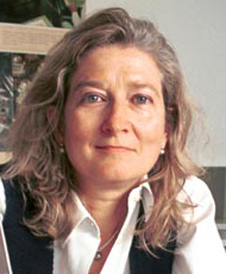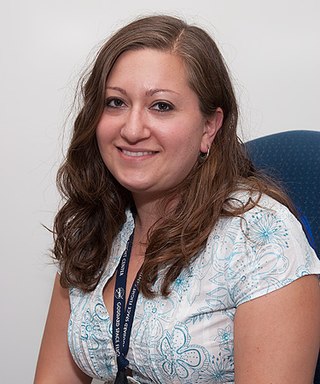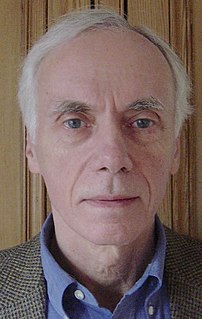Dr. Reuven Ramaty (1937—2001) was a Hungarian astrophysicist who worked for 30 years at NASA's NASA Goddard Space Flight Centre. He was a leader in the fields of solar physics, gamma-ray line spectrometry, nuclear astrophysics, and low-energy cosmic rays. Ramaty was a founding member of NASA's High Energy Solar Spectroscopic Imager which has now been renamed the Reuven Ramaty High Energy Solar Spectroscopic Imager in his honour. This was the first space mission to be named after a NASA scientist and was operational from 2002 until 2018. The Online Archive of California holds over 400 entries for documents, papers and photographs published by and of Ramaty and his work. Ramaty made many contributions in the field of astrophysics and solar physics. He was given the Goddard Lindsay Award in 1980 and had a tribute dedicated to his work at the University of Maryland in 2000.
The Bruno Rossi Prize is awarded annually by the High Energy Astrophysics division of the American Astronomical Society "for a significant contribution to High Energy Astrophysics, with particular emphasis on recent, original work". Named after astrophysicist Bruno Rossi, the prize is awarded with a certificate and a gift of USD $500, and was first awarded in 1985 to William R. Forman and Christine Jones Forman "for pioneering work in the study of X-ray emission from early type galaxies". It has been awarded 32 times. In 2010, the prize was awarded to William B. Atwood, Peter Michelson and the Fermi Gamma-ray Space Telescope team "for enabling, through the development of the Large Area Telescope, new insights into neutron stars, supernova remnants, cosmic rays, binary systems, active galactic nuclei, and gamma-ray bursts". In 2013, the prize was awarded to Roger W. Romani of Leland Stanford Junior University and Alice Harding of Goddard Space Flight Center for their work in developing the theoretical framework underpinning the many exciting pulsar results from Fermi Gamma-ray Space Telescope.
Stanford Earl Woosley is a physicist, and Professor of Astronomy and Astrophysics. He is the director of the Center for Supernova Research at University of California, Santa Cruz. He has published over 300 papers.

John Cromwell Mather is an American astrophysicist, cosmologist and Nobel Prize in Physics laureate for his work on the Cosmic Background Explorer Satellite (COBE) with George Smoot.

Jean Hebb Swank is an astrophysicist who is best known for her studies of black holes and neutron stars.

Cornelis A. "Neil" Gehrels was an American astrophysicist specializing in the field of gamma-ray astronomy. He was Chief of the Astroparticle Physics Laboratory at NASA's Goddard Space Flight Center (GSFC) from 1995 until his death, and was best known for his work developing the field from early balloon instruments to today's space observatories such as the NASA Swift mission, for which he was the Principal investigator. He was leading the WFIRST wide-field infrared telescope forward toward a launch in the mid-2020s. He was a member of the National Academy of Sciences and the American Academy of Arts and Sciences.

Gerald Jay (Jerry) Fishman is an American research astrophysicist, specializing in gamma-ray astronomy. His research interests also include space and nuclear instrumentation and radiation in space. A native of St. Louis, Missouri, Fishman obtained a B.S. with Honors degree in Physics from the University of Missouri in 1965, followed by M.S. and Ph.D. degrees in Space Science from Rice University in 1968 and 1970, respectively.

Patrizia Caraveo is an Italian astrophysicist.

Beth A. Brown was a NASA astrophysicist with a research focus on X-ray observations of elliptical galaxies and black holes. She earned a Ph.D. in Astronomy from the University of Michigan in 1998, becoming the first African-American woman to do so.

Dr. Martin C. Weisskopf is project scientist for NASA's Chandra X-ray Observatory and Chief Scientist for X-ray Astronomy in the Space Sciences Department at NASA's Marshall Space Flight Center in Huntsville, Alabama.

Chryssa Kouveliotou is a Greek astrophysicist. She is a professor at George Washington University and a retired senior technologist in high-energy astrophysics at NASA's Marshall Space Flight Center in Huntsville, Alabama.

Tracy Robyn Slatyer is a professor of particle physics with a concentration in theoretical astrophysics with tenure at MIT. She was a 2014 recipient of the Rossi Prize for gamma ray detection of Fermi bubbles, which are unexpected large structure in our galaxy. Her research also involves seeking explanations for dark matter and the gamma ray haze at the center of the Milky Way. In 2021, she was awarded a New Horizons in Physics Prize for "major contributions to particle astrophysics, from models of dark matter to the discovery of the "Fermi Bubbles."

Vassiliki Kalogera is a Greek astrophysicist. She is a professor at Northwestern University and the Director of the Center for Interdisciplinary Exploration and Research in Astrophysics (CIERA). She is a leading member of the LIGO Collaboration that observed gravitational waves in 2015.
Lynn Cominsky is an American astrophysicist and educator. She is currently the Chair of Astronomy and Physics at Sonoma State University in Rohnert Park, California, as well as the Project Director for the NASA Education and Public Outreach Group.

Judith Lea Racusin is an American astrophysicist. She works at Goddard Space Flight Center as a research aerospace technologist in fields and particles. Racusin researches gamma-ray bursts, supernova remnants, high-energy astrophysics, and instrumentation.

Rita M. Sambruna is an Italian-American astrophysicist and is the Deputy Director of the Astrophysics Science Division at National Aeronautics and Space Administration's (NASA) Goddard Space Flight Center. From September 2022 to January 2023, she was the Acting Deputy Director of the Science Exploration Directorate at Goddard. Rita held the Clare Boothe Luce Professorship in Physics and Astronomy at George Mason University in 2000-2005.

Péter István Mészáros is a Hungarian-American theoretical astrophysicist, best known for the Mészáros effect in cosmology and for his work on gamma-ray bursts.
Brenda Lynn Dingus is an American particle astrophysicist at the Los Alamos National Laboratory, known for her research on gamma-ray bursts and cosmic rays.
Elizabeth Anne Hays is an American astrophysicist at the NASA Goddard Space Flight Center, where she is chief of the Astroparticle Physics Laboratory and the project scientist for the Fermi Gamma-ray Space Telescope. Her research has included gamma-ray astronomy of the Crab Nebula, novae, and gamma-ray bursts.

Jane Rebecca Rigby is an American astrophysicist who works at the Goddard Space Flight Center and is Operations Project Scientist at the James Webb Space Telescope. She was elected one of Nature's 10 Ones to Watch in 2021.















